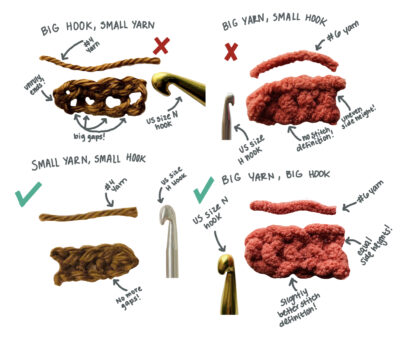
Crocheting With the Firehose by Ella T. '25, MEng '26
Gauge your stitches, gauge your life
Over the past few months, I have become obsessed with crochet.
Before I came to Boston, I dedicated quite some time to ironing out the logistics of crocheting at MIT. How will I pack all my yarn? What project should I begin on the airplane? Where is the nearest yarn store in Cambridge?01 Spoiler Alert: It's three stops on the Red Line to Porter Station To whom will I bestow crocheted gifts?
Now that I’m here, and I have an entire set of shelves dedicated to skeins of yarn and unfinished crochet projects, I can say that I’ve successfully woven in my crocheting with my life at MIT.
But why do I spend so much time crocheting? I’m surely not crocheting out of boredom. I’m also not crocheting for practicality, because a lot of what I crochet is functionally useless.02 At home, I crocheted bonnets for my cat
In the end, I think there is more to crochet than stitches. It’s a tangible representation of how I go about living.
How? Let’s go back to crochet.
The essence of crochet is creating an appealing piece. However, appealing is subjective and ultimately depends on the values of the maker and the functionality of the piece itself. For example, appealing construction can be important. An array of short, dense stitches will make a better pot holder03 Unless you'd like to burn yourself. Then use a triple crochet. than long, spacious stitches. Sometimes, appealing composition is important. That’s why these exist. Sometimes, appealing visuals are important, which is where hundreds of stitch variations come into play. However, there are some rules that are universally accepted by crocheters:

As you can see, it is best to use a hook size that matches your yarn size. If you try a different combination, you’ll run the risk of creating a less appealing piece. But what does that have to do with life?
If an important aspect of living is to make life as appealing as possible, then we must each have our own hook and yarn. The size of either depends on a number of factors, and the capability of one is relative to the other.
For example, when I look back to high school, I was surrounded with many people who, like myself, wielded “Big Hook, Small Yarn.” My robust hook, fortified by years of experience04 Rather, what I thought was experience at the time. and a sizable God Complex, was overpowering, and the yarn I worked with took the form of relatively easy academics. This formed a lifestyle resembling the top left crochet swatch — a poorly formed, scraggly piece with large gaps in purpose.
When I stepped foot on campus, my hook size shrunk dramatically. In reality, I carried the same hook size from high school, but in comparison to other hooks at MIT, it was obsolete. Even worse, my yarn size grew from small and manageable to a literal firehose. So, I found myself with a lifestyle resembling the top right crochet swatch — an overworked and extremely dense jumble of yarn.
Over time, one of two things occur: Your hook could level out with your yarn, and you become acclimated to the rigor of MIT. Otherwise, you adjust your yarn to match your hook, and you create a lifestyle that is most appealing. The first one seems more desirable, but the latter is more sustainable. You have control over your yarn.05 You <em>can </em>take 8.01L. You <em>can </em>drop that class. You <em>can</em> table the extracurricular
It is ideal, however, if you find an approximation for your optimal hook and yarn sizes before you’re in too deep. It saves a lot of time spent on the registration website or that problem set from the class you should really drop.
How do we do that?
Gauge your stitches. Gauging is a term used by crocheters to describe the planning that ensures your finished piece will turn out the way you mean it. At the beginning of a crochet pattern06 A recipe that tells you exactly how to stitch a project , the gauge will tell you to stitch a certain length of stitches by a certain width of stitches. Then, you measure the square you made. If your gauge doesn’t meet the measurement requirements, it means you crochet a little differently than the author of the pattern. It is perfectly fine to crochet a little differently than the author of the pattern. It just means that you might have to upsize your yarn or downsize your hook and gauge until it measures correctly.
So, to gauge life, you have to try some combinations and see what you make. See what you can handle. See what feels right. When you have a good idea of the right yarn size, and you accept your hook, you create more appealing pieces and a better life. You’ll know how to gauge for success in the future. But don’t shy away from experiencing bad combinations, either. There’s many a terrible sweater to be crocheted at MIT.
- Spoiler Alert: It's three stops on the Red Line to Porter Station back to text ↑
- At home, I crocheted bonnets for my cat back to text ↑
- Unless you'd like to burn yourself. Then use a triple crochet. back to text ↑
- Rather, what I thought was experience at the time. back to text ↑
- You can take 8.01L. You can drop that class. You can table the extracurricular back to text ↑
- A recipe that tells you exactly how to stitch a project back to text ↑